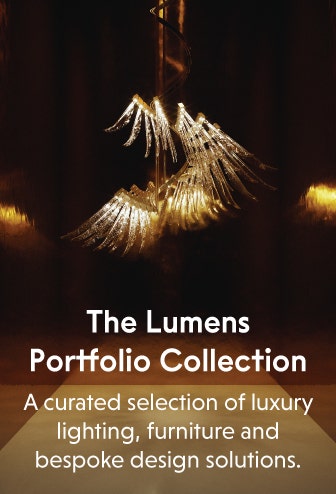-
New
-
New Arrivals New Lighting New Fans New Furniture New Rugs New Decor New Outdoor Lighting New Outdoor Furniture New Outdoor Accessories Shop All New ArrivalsNew Brands Atelier Loupiote Caracole Case Furniture DAQI Concept ferm LIVING In Common With MDF Italia Qeeboo Roger Pradier Rowe Furniture Sunpan Venicem Y.S.M.
Close -
-
Lighting
-
Ceiling Lights Chandeliers Pendant Lighting Flush + Semi-Flushmounts Linear Suspension Recessed Lighting Track + Monorail LED Ceiling Lights Design Ceiling LightsWall Lights Wall Sconces Bath + Vanity Lights Picture Lights Undercabinet Lights Accent Lights Lighted Mirrors LED Wall Lights Design Wall LightsFloor + Table Lamps Floor Lamps Table Lamps Desk + Task Lamps Cordless Lamps LED Floor + Table Lamps Design Floor + Table Lamps Accessories Light Bulbs Dimmers, Switches + Outlets
Close -
-
Outdoor
-
Outdoor Lighting Outdoor Wall Lights Outdoor Flush + Semi-Flushmounts Outdoor Pendant Lights Outdoor Chandeliers Outdoor Floor Lamps Outdoor Table Lamps Outdoor Cordless Lamps Landscape Lighting LED Outdoor Lighting Outdoor Fans Design Outdoor LightingOutdoor Lounge Furniture Outdoor Lounge Chairs Outdoor Sofas + Sectionals Outdoor Chaise Lounges Outdoor Daybeds Outdoor Ottomans + Low Stools Outdoor Coffee Tables Outdoor Side Tables Outdoor Benches Outdoor Game Tables Patio Conversation Sets Design Outdoor Lounge FurnitureOutdoor Dining + Bar Furniture Outdoor Dining Tables Outdoor Dining Chairs Outdoor Bar + Counter Stools Outdoor Bar Carts + Trolleys Outdoor Café + Bistro Tables Outdoor Bar Tables Outdoor Dining Sets Outdoor Dining Benches Design Outdoor Dining + Bar Furniture
Close -
- Fans
-
Furniture
-
Dining Room Furniture Dining Room Tables Dining Room Chairs Counter + Bar Stools Dining Benches Shelving + Storage Design Dining Room FurnitureLiving Room Furniture Lounge Chairs Accent Chairs Sofas Sectional Sofas Coffee Tables Side Tables Console Tables Ottomans + Stools Media Cabinets Living Room Shelving Game Room Furniture Design Living Room FurnitureBedroom Furniture Beds Dressers Nightstands + Bedside Tables Bedroom Chairs Bedroom Benches Design Bedroom Furniture
Close -
-
Rugs
Close
-
Décor
-
Décor Mirrors Wall Art Clocks Pillows + Throws Decorative Accessories Vases + Bowls Fireplaces + Accessories Humidifiers DiffusersStorage + Organization Wall Hooks + Racks Coat Racks Umbrella Stands Household Desk + Office AccessoriesBath Hardware + Accessories Bathroom Hardware Bathroom Accessories Bathroom Vanity Mirrors Towels + Bath Mats
Close -
-
Shop by
-
Shop by Style Mid-Century Modern Scandinavian Design Modern Farmhouse California Modern Rustic Modern Memphis Style Art Deco Artisanal Modern Classic + Traditional Avant-garde Glam Craftsman + MissionShop by Editor's Picks Gift Guide Sustainable Designs Masters of Design Lumens Exclusive Designs Award-Winning Designs Smart Home Be Original USA Made in USA Contract Grade Acoustic Lighting + Furniture The Design IconsShop by Designers Achille Castiglioni Arne Jacobsen Charles + Ray Eames Eero Saarinen Jasper Morrison Marcel Wanders Michele De Lucchi Patricia Urquiola Philippe Starck Piero Lissoni Ronan + Erwan Bouroullec Verner Panton
Close -
-
Brands
-
Exclusive Brands Alder & Ore A-N-D Atelier de Troupe Baselite Fabbian Huxe J. Adams & Co. Market Set Patrick Townsend Pilke Lights Point Luna RBW Rotaliana by Luminart Shop all exclusive brandsIconic Brands Artemide Audo Copenhagen B&B Italia Cappellini Carl Hansen FLOS Foscarini GUBI Herman Miller Kartell Louis Poulsen Moooi Nemo Oluce Shop all design brandsEmerging Brands ANONY Blueprint Lighting d'Armes Gabriel Scott Graypants Lambert & Fils Mash T Design Studio Matthew McCormick Studio MM Lampadari Petite Friture Roll & Hill Rosie Li Studio Stickbulb Tooy Shop all emerging brands
Close -
-
Trade
-
Portfolio Collection Designs Chandeliers Pendant Lights Linear Suspension Lights Flush + Semi-Flushmounts Outdoor Lighting Wall Sconces Bath + Vanity Lights Floor Lamps Table Lamps Recessed Lighting Lighting Systems Furniture Decor Shop All Portfolio Collection DesignsShop Trade by Trade Exclusive Designs Customizable Designs Contract Grade Accoustic Lighting + Furniture Sustainable Designs Lumens Exclusive Designs 277V Lighting Iconic Designs Sonneman SuspendersTrade Content + Events Trade Education: Earn CEU Credits Trade Education: Design on Demand Lumens Innovator Council The Grand Tourist + Lumens Trade Catalog Trade Source Book LDE @ 3daysofdesign: Tune In June 12-14 Lumens @ ICFF 2024Close
-
-
Inspiration
-
News + Editorial Q+A with Marcel Wanders A Look Inside the Lumens Design House New Design Leadership at SONNEMAN Victoria Tonelli Designs a Modern Retreat Meet the Makers: Best Interviews of 2023 The Innovators Predict 2024's Biggest Trends and More Adi Goodrich: A Day in the Life Cherner Chair Company's Iconic Cherner Chair Zafferano’s Pina Pro and Poldina CollectionIdeas + Advice Welcome Home Now Sourcing: Modern Retreat The Look: Natural + Organic Designing a Smart Home Light Bulb Facts Understanding CFM for Ceiling Fans Outdoor Lighting Guide The Ultimate Guide to Accent Furniture The Rug Buyer's Guide How to Choose a SofaDesign Brand Stories Audo Copenhagen: An Evolution of Danish Tradition B&B Italia: Icon of Italian Luxury FLOS: The New Language of Light Kartell: On the Cutting Edge Artemide: Italian by Design NEMO: Curators of Timeless Design Louis Poulsen: Design to Shape Light RBW: The New Chapter of Innovation SONNEMAN: A Way of Light
Close -
- SALE
- Contact Us



















